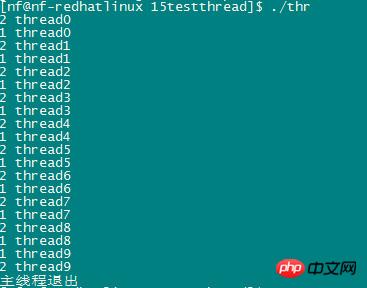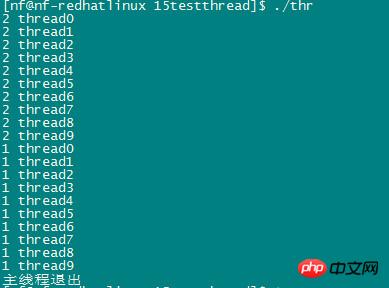linux下C语言的多线程编程的详细介绍
这篇文章主要介绍了linux下c语言的多线程编程,需要的朋友可以参考下
我们在写linux的服务的时候,经常会用到linux的多线程技术以提高程序性能
多线程的一些小知识:
一个应用程序可以启动若干个线程。
线程(Lightweight Process,LWP),是程序执行的最小单元。
一般一个最简单的程序最少会有一个线程,就是程序本身,也就是主函数(单线程的进程可以简单的认为只有一个线程的进程)
一个线程阻塞并不会影响到另外一个线程。
多线程的进程可以尽可能的利用系统CPU资源。
1创建线程
先上一段在一个进程中创建一个线程的简单的代码,然后慢慢深入。
#include<pthread.h>
#include<stdio.h>
#include<stdlib.h>
#include<string.h>
#include<errno.h>
void * func(void * arg)
{
printf("func run...\n");
return NULL;
}
int main()
{
pthread_t t1;
int err = pthread_create(&t1,NULL,func,NULL);
if(err!=0)
{
printf("thread_create Failed:%s\n",strerror(errno));
}else{
printf("thread_create success\n");
}
sleep(1);
return EXIT_SUCCESS;
}
int pthread_create(pthread_t *thread,const pthread_attr_t *attr, void *(*start_routine)(void*), void *arg);在main函数里面我们调用上面的函数进行创建一个线程。
函数参数:
第一个参数:pthread_t代表创建线程的唯一标识,是一个结构体,需要我们创建好后,将这个结构体的指针传递过去。
第二个参数:pthread_attr_t,代表创建这个线程的一些配置,比如分配栈的大小等等。。一般我们可以填NULL,代表默认的创建线程的配置
第三个参数:代表一个函数的地址,创建线程时,会调用这个函数,函数的返回值是void*,函数的参数也是void*,一般格式就像void * func(void * arg){}
第四个参数:代表调用第三个函数传递的参数
函数返回值:
函数成功返回0,如果不等于0则代表函数调用失败,此时通过strerror(errno)可以打印出具体的错误。
注意:每个线程都拥有一份errno副本,不同的线程拥有不同的errno
最后通过gcc编译
gcc 1createthread.c -c -o 1createthread.o gcc 1createthread.o -o thr1 -lpthread
编译的时候需要加上-lpthread 用来链接libpthread.so动态库,不然会提示找不到function
函数调用返回结果

问题:为什么调用sleep函数
答:可能新创建的线程还没运行到打印的方法主线程就结束了,而主线程结束,所有线程都会结束了。
2线程挂起
有时候我们在一个线程中创建了另外一个线程,主线程要等到创建的线程返回了,获取该线程的返回值后主线程才退出。这个时候就需要用到线程挂起。
int pthread_join(pthread_t th, void **thr_return);。
pthread_join函数用于挂起当前线程,直至th指定的线程终止为止。
#include<pthread.h>
#include<stdio.h>
#include<stdlib.h>
#include<string.h>
#include<errno.h>
void * func(void * arg)
{
int i=0;
for(;i<5;i++)
{
printf("func run%d\n",i);
sleep(1);
}
int * p = (int *)malloc(sizeof(int));
*p=11;
return p;
}
int main()
{
pthread_t t1,t2;
int err = pthread_create(&t1,NULL,func,NULL);
if(err!=0)
{
printf("thread_create Failed:%s\n",strerror(errno));
}else{
printf("thread_create success\n");
}
void *p=NULL;
pthread_join(t1,&p);
printf("线程退出:code=%d\n",*(int*)p);
return EXIT_SUCCESS;
}函数执行结果

我们主函数一直在等待创建的线程执行完,并且得到了线程执行结束的返回值
3线程终止
进程终止时exit()函数,那么线程终止是什么呢?
线程终止的三种情况:
线程只是从启动函数中返回,返回值是线程的退出码。
线程可以被同一进程中的其他线程取消。
线程调用pthread_exit。
#include<pthread.h>
#include<stdio.h>
#include<stdlib.h>
#include<string.h>
#include<errno.h>
void * func(void * arg)
{
int i=0;
while(1)
{
if(i==10)
{
int * p = (int *)malloc(sizeof(int));
*p=11;
pthread_exit(p);
}
printf("fun run %d\n",i++);
sleep(1);
}
return NULL;
}
int main()
{
pthread_t t1,t2;
int err = pthread_create(&t1,NULL,func,NULL);
if(err!=0)
{
printf("thread_create Failed:%s\n",strerror(errno));
}else{
printf("thread_create success\n");
}
void *p=NULL;
pthread_join(t1,&p);
printf("线程退出:code=%d",*(int*)p);
return EXIT_SUCCESS;
}
void pthread_exit(void *arg);pthread_exit函数的参数就跟正常线程结束return的使用时一样的,都会被等待它结束的主线程获取到。
函数运行结果:

4线程分离
int pthread_detach(pthread_t th);
pthread_detach函数使线程处于被分离状态。
如果不等待一个线程,同时对线程的返回值不感兴趣,可以设置这个线程为被分离状态,让系统在线程退出的时候自动回收它所占用的资源。
一个线程不能自己调用pthread_detach改变自己为被分离状态,只能由其他线程调用pthread_detach。
5线程取消
int pthread_cancel(pthread_t th);
pthread_cancel函数允许一个线程取消th指定的另一个线程。
函数成功,返回0,否则返回非0。
#include<pthread.h>
#include<stdio.h>
#include<stdlib.h>
#include<string.h>
#include<errno.h>
void * func1(void * arg)
{
while(1)
{
printf("fun run...\n");
sleep(1);
}
return NULL;
}
int main()
{
pthread_t t1;
if(pthread_create(&t1,NULL,func1,NULL)!=0)
{
printf("thread_create Failed:%s\n",strerror(errno));
return -1;
}
sleep(5);
pthread_cancel(t1);
pthread_join(t1,NULL);
return EXIT_SUCCESS;
}函数执行结果:

上面我们说过创建一个线程函数pthread_create的第二个参数,用来决定创建线程的一些初始化状态,这里我们 举个例子,改线程一创建就是分离状态的线程(
上面介绍了pthread_detach函数的概念,可以通过pthread_attr_t在创建线程的时候就指定线程属性为detach,而不用创建以后再去修改线程属性。
)
先上一段代码:
#include<pthread.h>
#include<stdio.h>
#include<stdlib.h>
#include<string.h>
#include<errno.h>
void * func(void * arg)
{
int i=0;
for(;i<5;i++)
{
printf("func run%d\n",i);
sleep(1);
}
int * p = (int *)malloc(sizeof(int));
*p=11;
return p;
}
int main()
{
pthread_t t1;
pthread_attr_t attr;//申明一个attr的结构体
pthread_attr_init(&attr);//初始化结构体
pthread_attr_setdetachstate(&attr, PTHREAD_CREATE_DETACHED);//设置线程为分离线程
int err = pthread_create(&t1,&attr,func,NULL);
if(err!=0)
{
printf("thread_create Failed:%s\n",strerror(errno));
}else{
printf("thread_create success\n");
}
pthread_attr_destroy(&attr);
pthread_join(t1,NULL);
printf("主线程退出\n");
return EXIT_SUCCESS;
}pthread_attr_t就是我们要传入的参数的结构体,一般申明的步骤有
1,申明一个pthread_attr_t对象
2,函数pthread_attr_init初始化attr结构。
3,设置线程的一些属性,比如pthread_attr_setdetachstate函数就是设置该线程创建的时候为正常状态还是分离状态。
4,函数pthread_attr_destroy释放attr内存空间
pthread_attr_setdetachstate把线程属性设置为下面两个合法值之一:
值 | 说明 |
PTHREAD_CREATE_DETACHED | 设置线程为分离状态 |
PTHREAD_CREATE_JOINABLE | 设置线程为正常状态 |
上面函数运行结果:

因为线程是个分离状态的,所以pthread_join挂起会失效,主线程很快运行结束,程序也就结束了,创建的线程还没来得及运行
线程同步
有时候我们多个线程处理订单扣减库存会遇到这样的问题,两个线程同时进入一段代码先查询库存,两个都查出来为还剩一件库存,第一个线程用掉这个库存后,将库存变为0,但是第二个线程刚才也查出来为1了,所以他还认为有库存,
这个时候操作就会引发我们想不到的意外,库存变为负数了!!所以这个时候就需要使用线程的同步!!
先上一段代码看看效果:
#include<pthread.h>
#include<stdio.h>
#include<pthread.h>
#include<stdio.h>
#include<stdlib.h>
#include<string.h>
#include<errno.h>
void * func(void * arg)
{
int threadno =*(int*)arg;
int i=0;
for(;i<10;i++)
{
printf("%d thread%d \n",threadno,i);
sleep(1);
}
return NULL;
}
int main()
{
pthread_t t1,t2;
int i1=1,i2=2;
pthread_create(&t1,NULL,func,&i1);
pthread_create(&t2,NULL,func,&i2);
pthread_join(t1,NULL);
pthread_join(t2,NULL);
printf("主线程退出\n");
return EXIT_SUCCESS;
}函数运行结果:

可以看到两个线程是没有规律的争相处理的,如果这段代码是扣减库存就完蛋啦!,所以我们要对这段代码进行加锁,同一时刻只能有一个线程进入操作!
先上代码:
#include<pthread.h>
#include<stdio.h>
#include<stdlib.h>
#include<string.h>
#include<errno.h>
pthread_mutex_t mutex = PTHREAD_MUTEX_INITIALIZER;
void * func(void * arg)
{
pthread_mutex_lock(&mutex);//对mutex加锁,其他线程进入后将会挂起,知道这个锁被解锁
int threadno =*(int*)arg;
int i=0;
for(;i<10;i++)
{
printf("%d thread%d \n",threadno,i);
sleep(1);
}
pthread_mutex_unlock(&mutex);
return NULL;
}
int main()
{
pthread_t t1,t2;
int i1=1,i2=2;
pthread_create(&t1,NULL,func,&i1);
pthread_create(&t2,NULL,func,&i2);
pthread_join(t1,NULL);
pthread_join(t2,NULL);
printf("主线程退出\n");
return EXIT_SUCCESS;
}函数运行结果:

可以看到第二个线程先进入后一直运行结束,对mutex解锁后,第一个线程才能进方法里面运行!否则会挂起,一直等到锁被解锁!
PTHREAD_MUTEX_INITIALIZER是初始化一个快速锁的宏定义。
pthread_mutex_t mutex = PTHREAD_MUTEX_INITIALIZER;
加锁解锁函数:
int pthread_mutex_lock(pthread_mutex_t *mutex); int pthread_mutex_unlock(pthread_mutex_t *mutex);
总结
以上是linux下C语言的多线程编程的详细介绍的详细内容。更多信息请关注PHP中文网其他相关文章!

热AI工具

Undresser.AI Undress
人工智能驱动的应用程序,用于创建逼真的裸体照片

AI Clothes Remover
用于从照片中去除衣服的在线人工智能工具。

Undress AI Tool
免费脱衣服图片

Clothoff.io
AI脱衣机

AI Hentai Generator
免费生成ai无尽的。

热门文章

热工具

记事本++7.3.1
好用且免费的代码编辑器

SublimeText3汉化版
中文版,非常好用

禅工作室 13.0.1
功能强大的PHP集成开发环境

Dreamweaver CS6
视觉化网页开发工具

SublimeText3 Mac版
神级代码编辑软件(SublimeText3)

热门话题
 linux怎么启动nginx
Apr 14, 2025 pm 12:51 PM
linux怎么启动nginx
Apr 14, 2025 pm 12:51 PM
在 Linux 中启动 Nginx 的步骤:检查 Nginx 是否已安装。使用 systemctl start nginx 启动 Nginx 服务。使用 systemctl enable nginx 启用在系统启动时自动启动 Nginx。使用 systemctl status nginx 验证启动是否成功。在 Web 浏览器中访问 http://localhost 查看默认欢迎页面。
 怎么查看nginx是否启动
Apr 14, 2025 pm 01:03 PM
怎么查看nginx是否启动
Apr 14, 2025 pm 01:03 PM
确认 Nginx 是否启动的方法:1. 使用命令行:systemctl status nginx(Linux/Unix)、netstat -ano | findstr 80(Windows);2. 检查端口 80 是否开放;3. 查看系统日志中 Nginx 启动消息;4. 使用第三方工具,如 Nagios、Zabbix、Icinga。
 linux怎么查看nginx是否启动
Apr 14, 2025 pm 12:48 PM
linux怎么查看nginx是否启动
Apr 14, 2025 pm 12:48 PM
在 Linux 中,使用以下命令检查 Nginx 是否已启动:systemctl status nginx根据命令输出进行判断:如果显示 "Active: active (running)",则 Nginx 已启动。如果显示 "Active: inactive (dead)",则 Nginx 已停止。
 nginx403错误怎么解决
Apr 14, 2025 pm 12:54 PM
nginx403错误怎么解决
Apr 14, 2025 pm 12:54 PM
服务器无权访问所请求的资源,导致 nginx 403 错误。解决方法包括:检查文件权限。检查 .htaccess 配置。检查 nginx 配置。配置 SELinux 权限。检查防火墙规则。排除其他原因,如浏览器问题、服务器故障或其他可能的错误。
 centos和ubuntu的区别
Apr 14, 2025 pm 09:09 PM
centos和ubuntu的区别
Apr 14, 2025 pm 09:09 PM
CentOS 和 Ubuntu 的关键差异在于:起源(CentOS 源自 Red Hat,面向企业;Ubuntu 源自 Debian,面向个人)、包管理(CentOS 使用 yum,注重稳定;Ubuntu 使用 apt,更新频率高)、支持周期(CentOS 提供 10 年支持,Ubuntu 提供 5 年 LTS 支持)、社区支持(CentOS 侧重稳定,Ubuntu 提供广泛教程和文档)、用途(CentOS 偏向服务器,Ubuntu 适用于服务器和桌面),其他差异包括安装精简度(CentOS 精
 docker原理详解
Apr 14, 2025 pm 11:57 PM
docker原理详解
Apr 14, 2025 pm 11:57 PM
Docker利用Linux内核特性,提供高效、隔离的应用运行环境。其工作原理如下:1. 镜像作为只读模板,包含运行应用所需的一切;2. 联合文件系统(UnionFS)层叠多个文件系统,只存储差异部分,节省空间并加快速度;3. 守护进程管理镜像和容器,客户端用于交互;4. Namespaces和cgroups实现容器隔离和资源限制;5. 多种网络模式支持容器互联。理解这些核心概念,才能更好地利用Docker。
 Centos停止维护2024
Apr 14, 2025 pm 08:39 PM
Centos停止维护2024
Apr 14, 2025 pm 08:39 PM
CentOS将于2024年停止维护,原因是其上游发行版RHEL 8已停止维护。该停更将影响CentOS 8系统,使其无法继续接收更新。用户应规划迁移,建议选项包括CentOS Stream、AlmaLinux和Rocky Linux,以保持系统安全和稳定。
 nginx怎么启动
Apr 14, 2025 pm 01:06 PM
nginx怎么启动
Apr 14, 2025 pm 01:06 PM
问题:如何启动 Nginx?答案:安装 Nginx启动 Nginx验证 Nginx 是否已启动探索其他启动选项自动启动 Nginx






